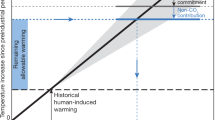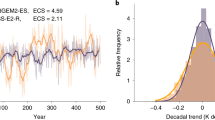Abstract
Climate targets are designed to inform policies that would limit the magnitude and impacts of climate change caused by anthropogenic emissions of greenhouse gases and other substances. The target that is currently recognized by most world governments1 places a limit of two degrees Celsius on the global mean warming since preindustrial times. This would require large sustained reductions in carbon dioxide emissions during the twenty-first century and beyond2,3,4. Such a global temperature target, however, is not sufficient to control many other quantities, such as transient sea level rise5, ocean acidification6,7 and net primary production on land8,9. Here, using an Earth system model of intermediate complexity (EMIC) in an observation-informed Bayesian approach, we show that allowable carbon emissions are substantially reduced when multiple climate targets are set. We take into account uncertainties in physical and carbon cycle model parameters, radiative efficiencies10, climate sensitivity11 and carbon cycle feedbacks12,13 along with a large set of observational constraints. Within this framework, we explore a broad range of economically feasible greenhouse gas scenarios from the integrated assessment community14,15,16,17 to determine the likelihood of meeting a combination of specific global and regional targets under various assumptions. For any given likelihood of meeting a set of such targets, the allowable cumulative emissions are greatly reduced from those inferred from the temperature target alone. Therefore, temperature targets alone are unable to comprehensively limit the risks from anthropogenic emissions.
This is a preview of subscription content, access via your institution
Access options
Subscribe to this journal
Receive 51 print issues and online access
$199.00 per year
only $3.90 per issue
Buy this article
- Purchase on Springer Link
- Instant access to full article PDF
Prices may be subject to local taxes which are calculated during checkout




Similar content being viewed by others
References
United Nations. Report of the Conference of the Parties on its Sixteenth Session, Cancun, 29 November to 10 December 2010 Document FCCC/CP/2010/7/Add. 1; http://unfccc.int/resource/docs/2010/cop16/eng/07a01.pdf (2011)
Zickfeld, K., Eby, M., Matthews, H. D. & Weaver, A. J. Setting cumulative emissions targets to reduce the risk of dangerous climate change. Proc. Natl Acad. Sci. USA 106, 16129–16134 (2009)
Meinshausen, M. et al. Greenhouse-gas emission targets for limiting global warming to 2 °C. Nature 458, 1158–1162 (2009)
Allen, M. R. et al. Warming caused by cumulative carbon emissions towards the trillionth tonne. Nature 458, 1163–1166 (2009)
Meehl, G. A. et al. Relative outcomes of climate change mitigation related to global temperature versus sea-level rise. Nature Clim. Change 2, 576–580 (2012)
Orr, J. C. et al. Anthropogenic ocean acidification over the twenty-first century and its impact on calcifying organisms. Nature 437, 681–686 (2005)
Steinacher, M., Joos, F., Frölicher, T. L., Plattner, G.-K. & Doney, S. C. Imminent ocean acidification in the Arctic projected with the NCAR global coupled carbon cycle-climate model. Biogeosciences 6, 515–533 (2009)
Running, S. W. A measurable planetary boundary for the biosphere. Science 337, 1458–1459 (2012)
Knox, J., Hess, T., Daccache, A. & Wheeler, T. Climate change impacts on crop productivity in Africa and South Asia. Environ. Res. Lett. 7, 034032 (2012)
Forster, P. et al. Climate Change 2007: The Physical Science Basis. Contribution of Working Group I to the Fourth Assessment Report of the Intergovernmental Panel on Climate Change Ch. 2 129–234 (Cambridge Univ. Press, 2007)
Rogelj, J., Meinshausen, M. & Knutti, R. Global warming under old and new scenarios using IPCC climate sensitivity range estimates. Nature Clim. Change 2, 248–253 (2012)
Knorr, W., Prentice, I. C., House, J. I. & Holland, E. A. Long-term sensitivity of soil carbon turnover to warming. Nature 433, 298–301 (2005)
Fung, I., Doney, S., Lindsay, K. & John, J. Evolution of carbon sinks in a changing climate. Proc. Natl Acad. Sci. USA 102, 11201–11206 (2005)
Moss, R. H. et al. The next generation of scenarios for climate change research and assessment. Nature 463, 747–756 (2010)
Weyant, J. R., de la Chesnaye, F. C. & Blanford, G. J. Overview of EMF-21: multigas mitigation and climate policy. Energ. J. (Spec. Iss. 3),. 1–32 (2006)
Grübler, A. et al. Integrated assessment of uncertainties in greenhouse gas emissions and their mitigation: introduction and overview. Technol. Forecast. Soc. 74, 873–886 (2007)
Calvin, K. et al. The role of Asia in mitigating climate change: results from the Asia modeling exercise. Energy Econ. 34 (3). S251–S260 (2012)
United Nations. United Nations Framework Convention on Climate Change Document FCCC/INFORMAL/84 GE. 05–62220 (E) 200705; http://unfccc.int/resource/docs/convkp/conveng.pdf (1992)
IPCC. Climate Change 2007: Synthesis Report. Contribution of Working Groups I, II and III to the Fourth Assessment Report of the Intergovernmental Panel on Climate Changehttp://www.ipcc.ch/publications_and_data/ar4/syr/en/contents.html (IPCC, 2007)
Rockström, J. et al. A safe operating space for humanity. Nature 461, 472–475 (2009)
Rougier, J. Probabilistic inference for future climate using an ensemble of climate model evaluations. Clim. Change 81, 247–264 (2007)
Tomassini, L. et al. Uncertainty and risk in climate projections for the 21st century: comparing mitigation to non-intervention scenarios. Clim. Change 103, 399–422 (2010)
Doney, S. C., Fabry, V. J., Feely, R. A. & Kleypas, J. A. Ocean acidification: the other CO2 problem. Annu. Rev. Mar. Sci. 1, 169–192 (2009)
Fabry, V. J., McClintock, J. B., Mathis, J. T. & Grebmeier, J. M. Ocean acidification at high latitudes: the bellwether. Oceanography 22, 160–171 (2009)
Kleypas, J. A. et al. Geochemical consequences of increased atmospheric carbon dioxide on coral reefs. Science 284, 118–120 (1999)
Hoegh-Guldberg, O. et al. Coral reefs under rapid climate change and ocean acidification. Science 318, 1737–1742 (2007)
Yara, Y. et al. Ocean acidification limits temperature-induced poleward expansion of coral habitats around Japan. Biogeosciences 9, 4955–4968 (2012)
Powlson, D. S. et al. Soil management in relation to sustainable agriculture and ecosystem services. Food Policy 36, S72–S87 (2011)
Boden, T. & Andres, B. Global CO2 emissions from fossil-fuel burning, cement manufacture, and gas flaring: 1751–2009. Data set. (Carbon Dioxide Information Analysis Center, Oak Ridge National Laboratory, 2012); http://cdiac.ornl.gov/ftp/ndp030/global.1751_2009.ems
Harrould-Kolieb, E. R. & Herr, D. Ocean acidification and climate change: synergies and challenges of addressing both under the UNFCCC. Clim. Policy 12, 378–389 (2012)
Church, J. A. et al. Revisiting the Earth’s sea-level and energy budgets from 1961 to 2008. Geophys. Res. Lett. 38, L18601 (2011)
Meinshausen, M. et al. The RCP greenhouse gas concentrations and their extension from 1765 to 2300. Clim. Change 109, 213–241 (2011)
Yamamoto-Kawai, M., McLaughlin, F. A., Carmack, E. C., Nishino, S. & Shimada, K. Aragonite undersaturation in the Arctic Ocean: effects of ocean acidification and sea ice melt. Science 326, 1098–1100 (2009)
Chan, N. C. S. & Connolly, S. R. Sensitivity of coral calcification to ocean acidification: a meta-analysis. Glob. Change Biol. 19, 282–290 (2013)
Schneider, K. & Erez, J. The effect of carbonate chemistry on calcification and photosynthesis in the hermatypic coral Acropora eurystoma . Limnol. Oceanogr. 51, 1284–1293 (2006)
Pandolfi, J. M., Connolly, S. R., Marshall, D. J. & Cohen, A. L. Projecting coral reef futures under global warming and ocean acidification. Science 333, 418–422 (2011)
Johnson, M. D. & Carpenter, R. C. Ocean acidification and warming decrease calcification in the crustose coralline alga Hydrolithon onkodes and increase susceptibility to grazing. J. Exp. Mar. Biol. Ecol. 434-435, 94–101 (2012)
Frieler, K. et al. Limiting global warming to 2 °C is unlikely to save most coral reefs. Nature Clim. Change 3, 165– 170. (2013)
Joos, F., Frölicher, T. L., Steinacher, M. & Plattner, G.-K. Ocean Acidification (eds Gattuso, J.-P. & Hansson, L. ) Ch. 14, 319–338 (Oxford Univ. Press, 2011)
Hickler, T. et al. CO2 fertilization in temperate FACE experiments not representative of boreal and tropical forests. Glob. Change Biol. 14, 1531–1542 (2008)
Strassmann, K. M., Joos, F. & Fischer, G. Simulating effects of land use changes on carbon fluxes: past contributions to atmospheric CO2 increases and future commitments due to losses of terrestrial sink capacity. Tellus B 60, 583–603 (2008)
Müller, S. A., Joos, F., Edwards, N. R. & Stocker, T. F. Water mass distribution and ventilation time scales in a cost-efficient, three-dimensional ocean model. J. Clim. 19, 5479–5499 (2006)
Parekh, P., Joos, F. & Müller, S. A. A modeling assessment of the interplay between aeolian iron fluxes and iron-binding ligands in controlling carbon dioxide fluctuations during antarctic warm events. Paleoceanography 23, PA4202 (2008)
Ritz, S. P., Stocker, T. F. & Joos, F. A coupled dynamical ocean-energy balance atmosphere model for paleoclimate studies. J. Clim. 24, 349–375 (2011)
Ritz, S. P., Stocker, T. F. & Severinghaus, J. P. Noble gases as proxies of mean ocean temperature: sensitivity studies using a climate model of reduced complexity. Quat. Sci. Rev. 30, 3728–3741 (2011)
Sitch, S. et al. Evaluation of ecosystem dynamics, plant geography and terrestrial carbon cycling in the LPJ dynamic global vegetation model. Glob. Change Biol. 9, 161–185 (2003)
Spahni, R., Joos, F., Stocker, B. D., Steinacher, M. & Yu, Z. C. Transient simulations of the carbon and nitrogen dynamics in northern peatlands: from the Last Glacial Maximum to the 21st century. Clim. Past Discuss. 8, 5633–5685 (2012)
McKay, M. D., Beckman, R. J. & Conover, W. J. A comparison of three methods for selecting values of input variables in the analysis of output from a computer code. Technometrics 21, 239–245 (1979)
Joos, F. et al. Global warming feedbacks on terrestrial carbon uptake under the Intergovernmental Panel on Climate Change (IPCC) emission scenarios. Glob. Biogeochem. Cycles 15, 891–907 (2001)
Isaaks, E. H. & Srivastava, R. M. Applied Geostatistics Ch. 12, 278–322 (Oxford Univ. Press, 1989)
Acknowledgements
We thank T. Kaminski for providing the Global Atmospheric Tracer Model (TM2) transport matrices, J. M. Lyman, H. Keith, and S. Gerber for providing observational data sets, R. Spahni, R. Roth, S. Ritz, B. Stocker and K. Strassmann for discussions and help with the model code, and K. Bieri for the IT support. We are grateful to the modelling teams participating in the EMF-21, International Institute for Applied Systems Analysis (IIASA) GGI, and AME projects for providing scenario data, and to the EMIC AR5 and coupled model intercomparison (CMIP5) projects for providing model forcing data sets. This project was funded by the Swiss National Science Foundation and the European Project on Ocean Acidification (EPOCA 211384) and the European Project CARBOCHANGE (264879) which both received funding from the European Commission’s Seventh Framework Programme (FP7/20072013).
Author information
Authors and Affiliations
Contributions
All authors contributed to designing the research and interpreting the results. M.S. ran the climate model, assembled the observational data sets, and performed the statistical analysis. M.S. wrote the paper with inputs from F.J. and T.F.S.
Corresponding author
Ethics declarations
Competing interests
The authors declare no competing financial interests.
Supplementary information
Supplementary Information
This file contains Supplementary Text and Data, Supplementary Tables 1-5, Supplementary Figures 1-19 and Supplementary References. (PDF 2690 kb)
Rights and permissions
About this article
Cite this article
Steinacher, M., Joos, F. & Stocker, T. Allowable carbon emissions lowered by multiple climate targets. Nature 499, 197–201 (2013). https://doi.org/10.1038/nature12269
Received:
Accepted:
Published:
Issue Date:
DOI: https://doi.org/10.1038/nature12269
This article is cited by
-
Assessing the remaining carbon budget through the lens of policy-driven acidification and temperature targets
Climatic Change (2023)
-
Can carbon emission reduction mitigate the PM2.5 air pollution? Evidence of the co-benefits from mitigating climate change
Environment, Development and Sustainability (2023)
-
Adaptive emission reduction approach to reach any global warming target
Nature Climate Change (2022)
-
A Satisficing Framework for Environmental Policy Under Model Uncertainty
Environmental Modeling & Assessment (2021)
-
Short-lived climate forcers have long-term climate impacts via the carbon–climate feedback
Nature Climate Change (2020)
Comments
By submitting a comment you agree to abide by our Terms and Community Guidelines. If you find something abusive or that does not comply with our terms or guidelines please flag it as inappropriate.



